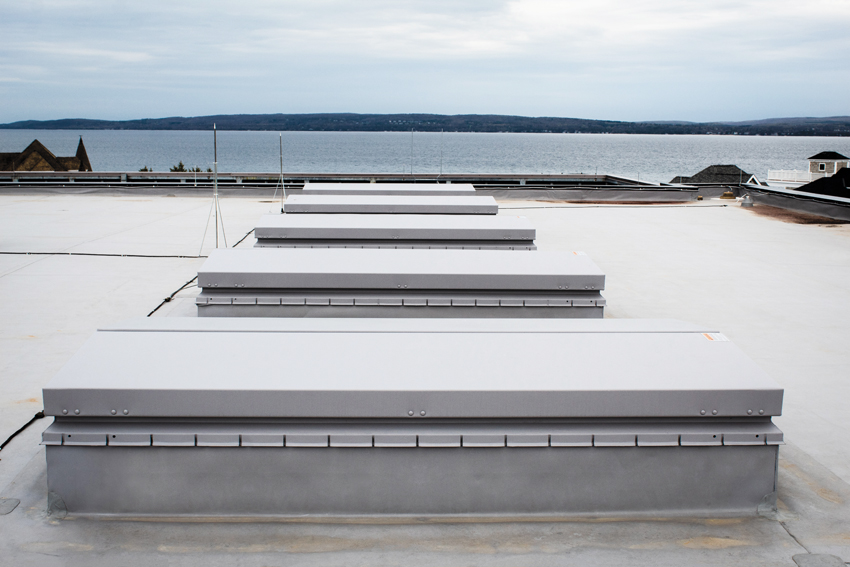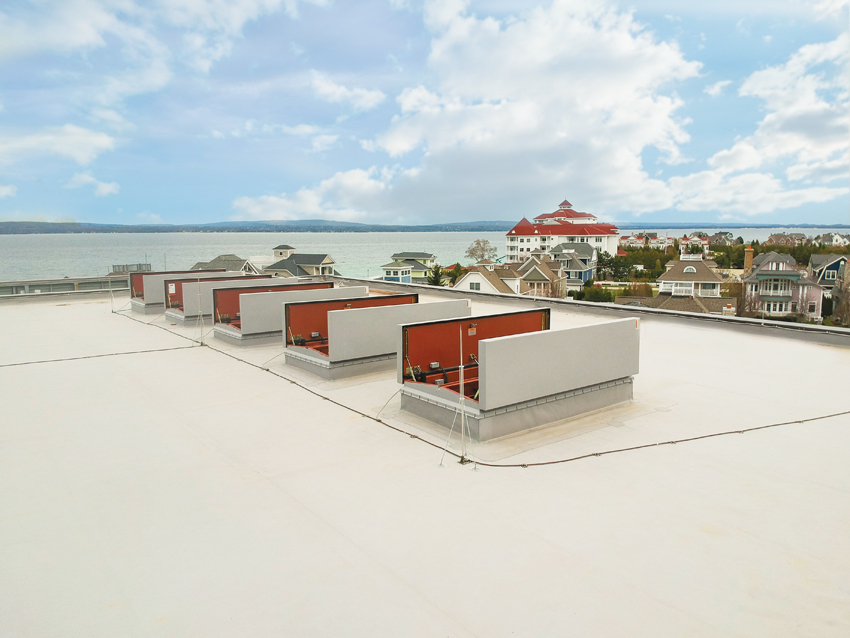Designing Roofs for Life Safety and Sound Isolation
Learning Objectives:
- Summarize how automatic smoke vents work in response to a fire event and how they modify the way that a fire progresses through a burning building.
- Select the appropriate noise-measuring metric to evaluate the sound-buffering performance of building facade products that need to mitigate noise made from airplanes, construction activities, and traffic.
- Explain the ways that automatic smoke vents are required to be incorporated into a design by the standard NFPA 204, authored by the National Fire Protection Association (NFPA), the 2018 International Building Code, and the International Fire Code (IFC).
- Describe the many ways that automatic smoke vents offer better protection for people, firefighters, and property in the event of a fire.
Credits:
This course is approved as a Structured Course
This course can be self-reported to the AANB, as per their CE Guidelines
Approved for structured learning
Approved for Core Learning
This course can be self-reported to the NLAA
Course may qualify for Learning Hours with NWTAA
Course eligible for OAA Learning Hours
This course is approved as a core course
This course can be self-reported for Learning Units to the Architectural Institute of British Columbia
There are many reasons that a project may need to be designed to mitigate exterior noise,” explains Harold Merck, INCE, LEED AP, principal at Merck & Hill Consultants. “Some spaces are sound sensitive, like the audience chamber or stage in a performing arts facility, while others have been constructed on noisy sites, near a railroad track or under a flight path. Sometimes the mechanical equipment on the roof generates a lot of noise that needs to be addressed as well. Whatever the reason, the building envelope can be designed to control the transmission of sound, just as it is designed to control temperatures and prevent water infiltration, and the roof area plays a critical role in achieving a sound management objective.”

All photos courtesy of The BILCO Company
Buildings that contain large, undivided open interiors, such as performing arts facilities, theaters, casinos, and convention centers, can benefit from acoustic smoke vents that prevent environmental noise from trespassing through the roof into the sound-sensitive interior spaces.
When projects must deliver greater levels of exterior sound mitigation, architects are required to spend more time shoring up the paths through which sound can most easily move from the outside to the inside. Openings are a common target of their attention. Just as openings in a building facade—doors and windows—can require soundproofing to reduce the transmission of noise from one side of the wall assembly to the other, openings made on the roof to accommodate automatic smoke vents or other products can benefit from solutions that have been specially engineered to manage sound.
This course explores the application of sound-rated smoke vents to isolate exterior noise and protect the acoustic performance and comfort of the interior space. Various metrics used to measure sound-buffering performance will be compared. An overview of the building codes that require the use of these automatic smoke vents will also be discussed, and the benefits of these life-safety products will be summarized. Projects where these acoustical smoke vents have been installed are also profiled.
Great Lakes Center for the Performing Arts
The Great Lakes Center for the Arts is a 40,000-square-foot, state-of-the-art performance facility located in Petoskey, Michigan, a popular vacation destination for families that is now also an enticing space for world-class performers. At the heart of this $25-million project is a 525-seat auditorium outfitted with cutting-edge sound technology found in only a few theaters across the country. Both the beauty of the building and the functionality of the acoustics were critical aspects of the design that architects considered while creating this venue to deliver a top-tier experience.
“This building adds a space for world-class performers to stop that did not exist in Northern Michigan,” says Jason Novotny, lead architect for TowerPinkster, the firm that designed the building. “With this being a high-performing acoustical environment, we designed a separate structure for the performance hall from the remainder of the building. This was solely for acoustical isolation of building elements.”
“With the potential for more than 500 visitors, our team knew we would have a need for a dependable smoke ventilation system,” Novotny explains. “The acoustical smoke vents with their acoustical sound-reducing characteristics became a part of this ‘shell-within-a-shell’ structure.”
Smoke vents installed in the roof of the facility provide significant fire and life-safety benefits. In the event of a fire, the vents open automatically to allow smoke, heat, and gases out of the burning building. This prevents the buildup of these dangerous elements and enables air quality and visibility to be maintained so that guests can safely exit the building and firefighters can enter to do their job.
Some smoke vents are designed to block outside noise from trespassing into the interior and compromising the sound comfort level of the indoor space. They are called acoustically sound-rated automatic smoke vents. There are five of these acoustical smoke vents in the roof of the Great Lakes Center for the Arts that block outside noise from penetrating into the interior and help to maintain the quality of the sophisticated sound system.
Beyond the attention to creating impressive sound quality, the architectural team went to great lengths to develop a theme for the space that incorporated local colors and textures. “We included aged copper, Petoskey stone, natural sedimentary rock, and of course, the beautiful blue waters of Lake Michigan,” Novotny says.
“The color palette and design features intentionally reflect the beauty of Northern Michigan, with blues, sands, grays, copper, and patterns and textures that evoke the water of Lake Michigan,” says Jill O’Neill, executive director of the center. Even the roof is an architectural element with the curvilinear wood ceiling resembling waves of the nearby lake. There is also a large rooftop terrace with stunning lake views.
Regardless of whether an audience is enjoying classical music, ballet, intellectual dialogue, comedy, country music, cinema, jazz, or any other event hosted at the Great Lakes Center for the Arts, it will be an experience to remember. To better understand how the design team created this safe, code-compliant, and sophisticated facility, let us now take a closer look at the acoustical smoke vents that were selected for the roof.

Architects of the Great Lakes Center for the Arts in Petoskey, Michigan, selected sound-rated smoke vents to provide life-safety benefits and support the world-class performance space.

















